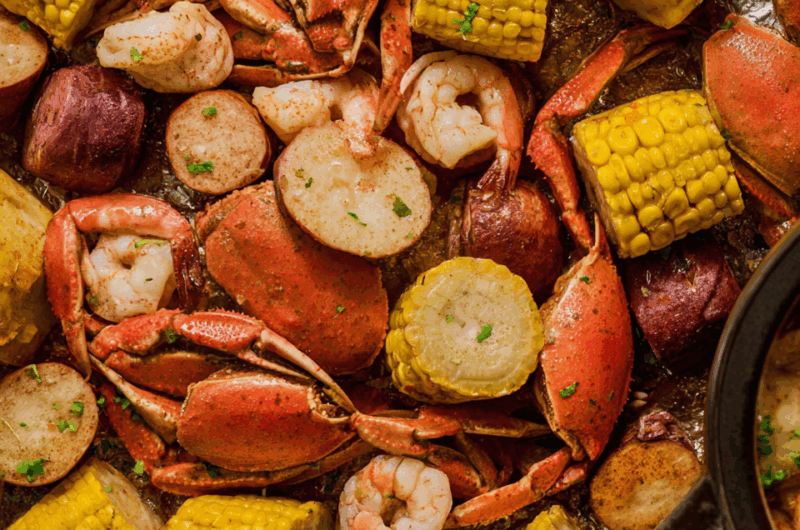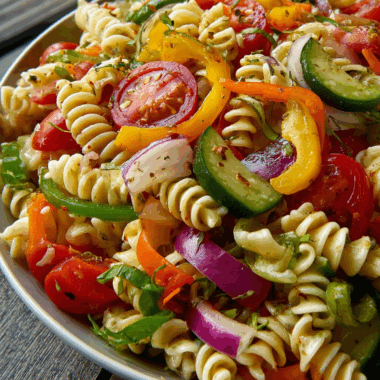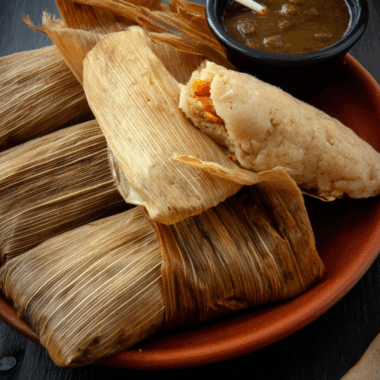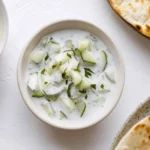Few dishes capture the spirit of Southern hospitality like a Low Country Boil. This hearty, flavorful one-pot meal brings together shrimp, sausage, potatoes, and corn in a seasoned broth that’s brimming with coastal charm. The best part? It’s traditionally served in the simplest way possible—spilled onto a newspaper-lined table where everyone digs in together.
Perfect for large gatherings, cookouts, or summer evenings by the water, this dish is more than just a meal—it’s an experience. The combination of savory sausage, sweet corn, tender potatoes, and juicy shrimp creates a comforting yet festive spread that celebrates the flavors of the South in every bite.
Full Recipe:
-
5 quarts water
-
1 (3-ounce) package crab boil seasoning (such as Zatarain’s)
-
4 tablespoons Old Bay seasoning
-
2 pounds new red potatoes
-
2 (16-ounce) packages cooked smoked sausage, cut into 1 ½-inch pieces
-
6 ears fresh corn, halved
-
4 pounds large shrimp, unpeeled
-
Optional: lemon wedges and cocktail sauce for serving
Directions:
-
In a large stockpot, bring 5 quarts of water to a rolling boil.
-
Add the crab boil seasoning packet and Old Bay seasoning to the water, stirring well.
-
Place the potatoes in the pot and cook for 10 minutes.
-
Add the sausage and cook for another 5 minutes.
-
Add the corn and continue cooking for 5 minutes.
-
Finally, add the shrimp and cook for 3 minutes, or until they turn pink.
-
Drain the pot immediately and transfer everything to a large serving platter or a newspaper-lined table for a traditional Southern-style presentation.
-
Serve with lemon wedges, melted butter, or cocktail sauce on the side.
Prep Time: 15 minutes | Cooking Time: 25 minutes | Total Time: 40 minutes
Kcal: 490 kcal | Servings: 8 servings
The Tradition of the Low Country Boil
The Low Country Boil is more than just a meal—it’s a communal experience rooted in Southern hospitality and coastal culture. Originating along the southeastern coastline of the United States, particularly in South Carolina and Georgia, this dish is a vibrant reflection of the region’s history, geography, and people. Families, friends, and neighbors often gather around a long table covered with newspapers, where the steaming pot of seafood, sausage, potatoes, and corn is poured out for everyone to share. It’s a dish that invites conversation, laughter, and connection, making it a centerpiece for social gatherings.
Coastal Origins and Cultural Significance
The story of the Low Country Boil is deeply tied to the waters of the Atlantic and the traditions of the Gullah Geechee community. The “Low Country” refers to the coastal areas of South Carolina and Georgia, where shrimping has long been a way of life. Historically, fishermen needed simple, hearty meals that could feed a crowd after long days on the water. Boiling fresh shrimp with seasonal produce like corn and potatoes, then seasoning it generously with spices, became a natural and efficient solution. Over time, this humble one-pot dish became a cultural staple, representing the marriage of African, European, and Caribbean culinary influences that define the region’s foodways.
A Feast for Gatherings
Unlike many recipes designed for intimate meals, the Low Country Boil is tailor-made for large groups. Whether it’s a family reunion, a summer cookout, or a beachside picnic, the boil thrives in settings where sharing food fosters connection. The informal nature of the dish—dumped out onto a table for guests to grab by hand—encourages togetherness and camaraderie. There’s no need for fancy silverware or plating; instead, the focus is on community, laughter, and the shared joy of good food.
Seasonal Flexibility and Regional Variations
One of the strengths of the Low Country Boil is its adaptability. While shrimp is the star of the show, variations abound depending on location and availability. In Louisiana, crawfish might replace shrimp, creating what’s known as a crawfish boil. In coastal Florida, crab legs or clams might be included for a more seafood-heavy version. Some families choose to spice it up with additional Cajun seasonings, while others keep it mild to highlight the natural flavors of the shrimp and vegetables. The dish evolves with the seasons and the catch of the day, making it both versatile and ever-refreshing.
The Role of Seasoning
No Low Country Boil is complete without a generous dose of seasoning. Traditional spice blends like Old Bay, Zatarain’s crab boil, or custom family recipes transform the pot into a flavorful medley that seeps into every bite. The balance of salty, spicy, and aromatic notes is what elevates the dish from a simple combination of ingredients into a celebrated Southern classic. Lemon wedges and dipping sauces—like cocktail sauce or melted butter—are often served alongside to add even more flavor layers.
Cooking as a Social Event
Part of the charm of a Low Country Boil lies in the cooking process itself. The act of gathering around a massive pot, stirring as the steam rises, builds anticipation and excitement among guests. It’s a spectacle that engages everyone, turning meal preparation into entertainment. Friends often bring side dishes, drinks, or desserts, but the main attraction is always the steaming pile of shrimp, sausage, and corn at the center of the table. In this way, cooking becomes an event rather than a chore, and the meal is as much about the process as it is about the final product.
Nutrition and Balance
Although the Low Country Boil is hearty and indulgent, it also provides a balance of nutrients. Shrimp is high in protein and low in fat, offering a lean source of energy. Potatoes contribute fiber and essential vitamins, while corn adds natural sweetness and texture. Sausage brings richness and depth, making the dish satisfying and robust. By serving the meal with fresh lemon wedges or a simple salad, you can round out the nutritional profile, offering a feast that is both delicious and nourishing.
Serving the Dish
Presentation plays a huge role in the dining experience of a Low Country Boil. Traditionally, the cooked ingredients are drained and dumped directly onto a table lined with newspapers or butcher paper. This casual, rustic approach eliminates the need for dishes and adds to the festive spirit. Guests gather around the table with their hands, napkins, and sometimes seafood crackers, ready to peel shrimp and savor the smoky sausage. The lack of formality is intentional—it’s about enjoying food in its most authentic and unpretentious form.
Why It’s Perfect for Outdoor Dining
The Low Country Boil is almost synonymous with outdoor dining. Its ease of preparation, large serving size, and minimal cleanup make it ideal for backyard parties, beachside gatherings, or summer cookouts. Since the dish doesn’t rely on complicated techniques, it’s approachable even for beginner cooks. The only requirements are a big enough pot, a reliable heat source, and plenty of hungry guests. The outdoor setting also enhances the experience—laughter, sunshine, and the sound of the ocean breeze all contribute to the atmosphere.
Modern Twists on a Classic
While traditionalists prefer to stick to the time-tested shrimp, sausage, corn, and potatoes combination, many modern cooks enjoy adding their own twist. Some incorporate crab legs or mussels for a seafood extravaganza, while others experiment with different sausages like chorizo or andouille for bolder flavors. Vegetarian adaptations replace the shrimp and sausage with mushrooms, tofu, or plant-based alternatives, proving that the essence of the dish lies not in specific ingredients, but in the act of gathering and sharing.
The Symbolism of Sharing Food
In many cultures, sharing food from a common source symbolizes unity, trust, and kinship. The Low Country Boil embodies this concept beautifully. By eliminating individual plates and utensils, the meal creates a sense of equality and togetherness. Everyone eats from the same spread, laughs over the same table, and enjoys the same flavors. It’s a reminder that food has the power to break down barriers and bring people closer, one handful of shrimp at a time.
Conclusion
The Low Country Boil is far more than a regional recipe—it’s a celebration of community, culture, and culinary tradition. Born out of the coastal waters of the American South, it has grown into a beloved symbol of togetherness that transcends geographical boundaries. Whether you’re hosting a summer gathering, a family reunion, or a casual weekend dinner, the Low Country Boil offers not just a feast for the stomach, but also for the heart. Its beauty lies in its simplicity, its adaptability, and its ability to transform a meal into an unforgettable experience. In a world where meals are often rushed and individualized, the Low Country Boil stands as a reminder of the joy that comes from slowing down, sharing, and savoring food with the people who matter most.








